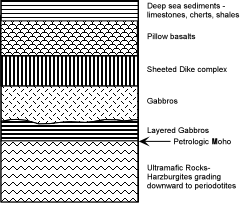
| EENS 2120 | Petrology |
Prof. Stephen A. Nelson |
Igneous Rocks of the Ocean Basins |
||
The Ocean Basins The ocean basins cover the largest area of the Earth's surface. Because of plate tectonics, however, most oceanic lithosphere eventually is subducted. Thus the only existing oceanic lithosphere is younger than about Jurassic in age and occurs at locations farthest from the oceanic spreading centers. Except in areas where magmatism is intense enough to build volcanic structures above sea level, most of the oceanic magmatism is difficult to access. Samples of rocks can be obtained from drilling, dredging, and expeditions of small submarines to the ocean floor. Numerous samples have been recovered and studied using these methods. Most of the magmatism is basaltic. Still, few drilling expeditions have penetrated through the sediment cover and into the oceanic lithosphere. Nevertheless, we have a fairly good understanding of the structure of the oceanic lithosphere from seismic studies and ophiolites. Here we will first look at ophiolites, then discuss basaltic magmatism in general, and then discuss the various oceanic environments where magmatic activity has occurred. Ophiolites |
| An idealized ophiolite sequence shows an upper layer consisting of deep sea sediments (limestones, cherts, and shales), overlying a layer of pillow basalts. Pillow basalts have a structure consisting of overlapping pillow-shaped pods of basalt. Such pillow structure is typical of lavas erupted under water. The pillow basalts overly a layer consisting of numerous dikes, some of which were feeder dikes for the overlying basalts. Beneath the sheeted dike complex are gabbros that likely represent the magma chambers for the basalts. The upper gabbros are massive while the lower gabbros show layering that might have resulted from crystal settling. |  |
| At the base of the layered gabbros there is a sharp increase in the density of the
rocks, and the composition changes to ultramafic rocks. This sharp change in density
is correlated with what would be expected at the base of the crust, and is thus referred
to as the petrologic moho. At the top of the ultramafic sequence the rock type is
harzburgite (Ol + Opx), a rock type expected to be the residual left from partially
melting peridotite. The base of the ultramafic layer is composed of peridotite.
Because most ophiolites have been hydrothermally altered, most of the mafic rocks
have been altered to serpentinite. Note that ophiolite means "snake rock". Volcanic Settings
Thus, most oceanic magmatism is basaltic, so we will first discuss basaltic magmas in general. |
Basalts On a chemical basis, basalts can be classified into three broad groups based on the degree of silica saturation. This is best seen by first casting the analyses into molecular CIPW norms (the same thing as CIPW norms except the results are converted to mole % rather than weight %). On this basis, most basalts consist predominantly of the normative minerals - Olivine, Clinopyroxene, Plagioclase, and Quartz or Nepheline. |
These minerals are in the 4 component normative system Ol-Ne-Cpx-Qtz,
shown here as a tetrahedron. In the tetrahedron, plagioclase plots between Ne and
Qtz, and Opx plots between Ol and Qtz. The basalt tetrahedron can be divided into
three compositional volumes, separated by planes.
|
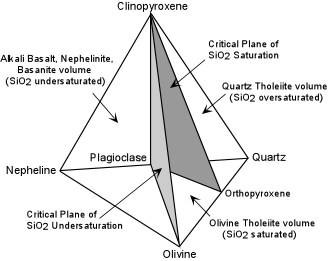 |
Note that tholeiitic basalts are basalts that show a reaction relationship of olivine to liquid which produces a low-Ca pyroxene like pigeonite or Opx. Both olivine tholeiites and quartz tholeiites would show such a relationship and would eventually precipitate either Opx or pigeonite. The critical plane of silica undersaturation appears to be a thermal divide at low pressure. This means that compositions on either side of the plane cannot produce liquids on the other side of the plane by crystal fractionation. To see this, look at the front two faces of the basalt tetrahedron. These are in the three component systems Ol-Cpx-Qtz and Ol-Cpx-Ne. These two faces are laid out side by side in the diagram below. |
| Experiments conducted on natural basalt compositions were run until liquids were found to be in equilibrium with at least Ol, Cpx, and Plagioclase. Such liquids would plot on a cotectic surface in the four component system represented by the basalt tetrahedron. These compositions were then projected from plagioclase onto the front two faces, shown here, to find the projection of the Ol-Plag-Cpx cotectic (the boundary curve along which Ol, Plag, Cpx, and Liquid are in equilibrium). | 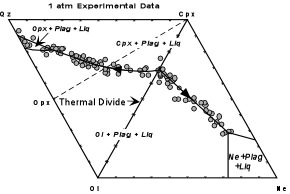 |
| Experimental liquid compositions fairly well define the projection of this cotectic onto the two front faces as seen here. |
| Although some information is lost in the projection, we can still treat these two phase diagrams in the same way that we treat normal phase diagrams. Note that a composition projecting into the field of Ol + Plag + Liq in the Ol-Cpx-Ne part of the diagram would first crystallize Plagioclase and move onto the plane of projection. Next Ol would precipitate and the liquid composition would change in a direct path away from the Olivine corner of the diagram until it hits the Ol+Plag+Cpx+Liq cotectic. For compositions on this side of the diagram, the liquid composition would then change along the boundary curve until it eventually precipitated Nepheline. A composition projecting into the Ol-Cpx- Qz triangle, on the other hand, would first crystallize plagioclase then crystallize Olivine. The liquid composition would then move in a direct path away from Olivine until it hit the Ol+Plag+Cpx boundary curve. But these compositions would then follow a path away from the Ol-Cpx join toward the Qz corner of the diagram and would eventually precipitate Opx. As this experimental data shows, the join Ol-Cpx (which is the projection of the critical plane of silica undersaturation) is a thermal divide at low pressure. Thus, low pressure crystal fractionation of tholeiitic basalts cannot produce silica undersaturated basalts and low pressure crystal fractionation of silica undersaturated basalts cannot produce tholeiitic basalts. Mantle peridotite, because it contains Opx, would plot in the Ol-Cpx-Opx part of the diagram. Note that at low pressure, only silica oversaturated liquids could be produced by melting such a peridotite. Furthermore, because of the low pressure thermal divide, silica undersaturated liquids could never be produced unless the peridotite had a silica undersaturated composition (i.e. it was Nepheline normative). High pressure experiments reveal a solution to this problem. In these experiments basaltic material was placed in a sandwich between layers of peridotite. The peridotite sandwiches were then placed in an experimental apparatus at various high pressures and temperatures and then quenched. Compositions of the liquid in equilibrium with the peridotite at various pressures was then determined. |
| These results are plotted in a somewhat different projection shown here. This plots molecular norms in the triangle Qz-Ol - Ne. This is equivalent to the base of the basalt tetrahedron, where the critical plane of silica saturation is represented by the Opx - Plag join, and the critical plane of silica undersaturation is represented by the Ol - Plag join. All experimental liquid compositions are surrounded by a shaded field indicating the pressure at which the experiments were run. To see how this projection works, let's look at the experiments run at 30 kb pressure. | 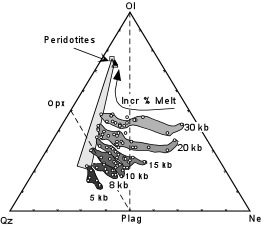 |
| At 30 kb pressure the first liquids to form from melting of peridotite would be those farthest away from the peridotite. Note that these liquids would be highly silica undersaturated. |
| With increasing degrees of melting the liquid composition would
change along a path toward the Ol - Plag join and eventually become silica saturated (they
would enter the Opx - Plag - Ol compositional triangle). Eventually both Cpx and Opx
in the original peridotite would be used up, leaving only Olivine, at which point the
composition of the liquid would change along a direct path toward Olivine until the liquid
composition reached the composition of the original peridotite at which point the
peridotite would be 100% melted. Melting at other pressures would follow a similar
path. With increasing degrees of melting they would change first toward silica
saturation then towards the original peridotite.
Note that as pressure is reduced, the lowest degree of melting produces less silica undersaturated melts. In fact, at pressures of 8 and 10 kb the first liquids produced are silica saturated liquids, and at 5 kb the first liquids are silica oversaturated. These experimental results bring out two important points:
We will refer to these two important points in the following discussion of the various oceanic settings. |
|
Mid Ocean Ridge Basalts (MORBs) Occurrence |
| Magma is both erupted and intruded near the central depressions that form the oceanic ridges. Thus, both basalts and gabbros are produced. But, little is known of the gabbros since they are rarely exposed and most oceanic lithosphere eventually is subducted. The main melting mechanism is likely decompression melting as rising convection cells move upward through the mantle beneath the ridges. At most oceanic ridges the basalts that are erupted are tholeiitic basalts sometimes referred to as NMORBs (normal MORBs) |
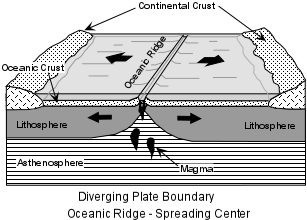 |
| At Iceland, the rate of magma production is so high that volcanism has built the oceanic ridge above sea level. Most of the active volcanism occurs within two central rift zones that cut across the island. Again, the predominant type of basalts erupted are tholeiitic basalts, however, these are somewhat different from NMORBs, showing higher concentrations of incompatible trace elements. Thus, they are often referred to as Enriched MORBs (EMORBs). Unlike normal oceanic ridges, a significant volume of rhyolite is also erupted in Iceland. This was once thought to suggest that continental crust underlies Iceland, but it is more likely that the rhyolites are produced by either crystal fractionation of the basalts or partial melting of the oceanic crust beneath Iceland. | 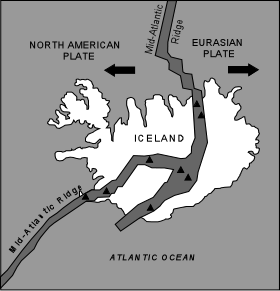 |
| Small volumes of alkali basalt have also erupted in Iceland. This alkaline
volcanism occurs on top of the tholeiitic basalts and erupts in areas to the east and west
of the main rift zones that cut across the island.
|
Composition
|
|
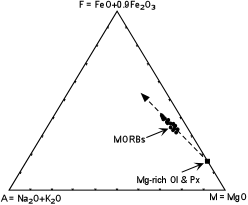 |
|
|
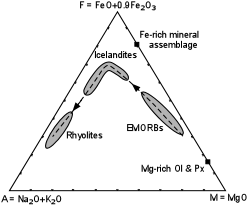 |
|
The projected phase diagram shown here is the system Ol-Cpx-SiO2, the front face of the basalt tetrahedron. Shown on the diagram is the projected cotectic along which Ol + Plag + Cpx + Liquid are in equilibrium as determined by 1 atmosphere experiments on numerous basalt compositions. Arrows on the boundary curve show direction of falling temperature. Also shown are parts of the Ol + Plag + Opx + Liq cotectic and parts of the Cpx + Plag + Opx + Liq cotectic. Note that these three boundary curves meet at a point on the diagram where Ol + Cpx + Opx would be in equilibrium with liquid. |
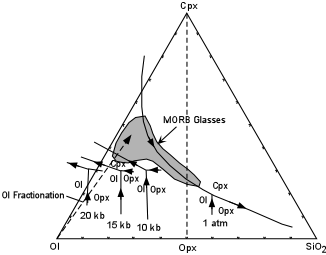 |
These intersecting boundary curves are also shown at pressures of 10, 15, and 20
kb. Partial melting of peridotite, containing Ol + Cpx + Opx at any of these
pressures would first produce liquids with a composition at the intersection of the
boundary curves. Note that the composition of the first liquid produced shifts away
from the SiO2 corner of the diagram with increasing pressure. |
|
On the diagram the concentration of each trace element in the rocks (MORBs in this case) is divided by the concentration estimated for the Bulk Earth. The trace elements are plotted in order of decreasing incompatibility, from most incompatible to less incompatible. |
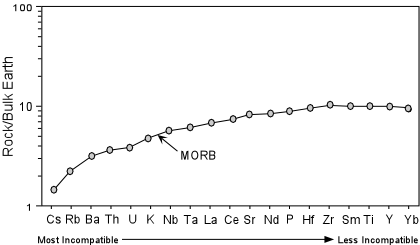 |
|
Imagine that we start out with a mantle that has the composition of the Bulk Earth. Such a mantle will have trace element concentrations equal to the bulk earth, and therefore the normalized trace element concentrations will all plot at a value of 1.0 |
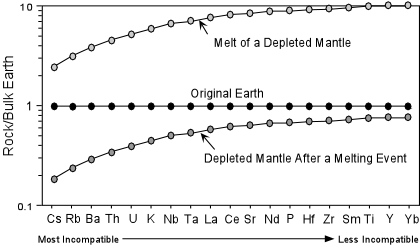 |
|
|
Another isotopic system to consider is the Sm - Nd system. Note that both of
these elements are REEs. In this system the parent radioactive isotope is 147Sm.
147Sm decays to 143Nd with a half-life of 106 billion years.
Note that in the incompatible element diagram above, the parent Sm isotope in a
depleted mantle has higher concentrations than the daughter Nd isotope. Thus, in a
mantle depleted in the most incompatible elements at some time in the past will produce
more of the daughter 143Nd isotope than the original undepleted Bulk Earth
composition. Note that this relationship is just the opposite of the Rb-Sr system.
144Nd is a stable, nonradiogenic isotope of Nd. Thus, the amount
of 144Nd in any rock does not change with time. So, in a depleted mantle,
and any magmas derived from melting of such a depleted mantle the 143Nd/144Nd
ratio will increase to higher values than in an undepleted mantle of Bulk Earth
composition. The 143Nd/144Nd ratio of the Bulk Earth is
expected to be about 0.51268. |
But 143Nd/144Nd ratios of MORBs show higher values, ranging from
0.5130 to 0.5133. Thus, the 143Nd/144Nd ratios of MORBs are
also consistent with their derivation from a depleted mantle. |
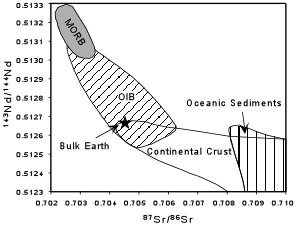 |
| Origin Here we summarize what we have discussed so far concerning the origin of MORBs.
|
Ocean Island Basalts (OIBs) As discussed previously, the oceanic islands are, in general, islands that do not occur along the divergent or convergent plate boundaries in the ocean basins. Nevertheless, EMORBs, such as those that occur in Iceland, as well as the Alkalic basalts of Iceland have much in common with magmas erupted in the oceanic islands. In the Atlantic Ocean, which is a slow-spreading oceanic basin, as well as in the Galapagos Islands of the eastern Pacific Ocean, some of the islands occur close to oceanic ridge spreading centers. In all cases we must keep in mind that the parts of these islands that are accessible for sampling represent only a fraction of the mass of the volcanic structures which rise from the ocean floor at depths up to 10,000 m. Thus, as with the ocean ridge volcanic rocks, there is a potential sampling problem. Here we discuss not only the magmatism that has occurred recently at
Oceanic Islands, but also the magmatism that produced massive submarine plateaus on the
sea floor during the Cretaceous. The latter are often referred to as Large Igneous
Provinces (LIPs). Oceanic Islands If these rising plumes of hot mantle remain stationary in their positions
in the mantle, they produce hot spots, as discussed previously. Hot spots are most
recognizable when they occur beneath plates that move with higher velocities. Beneath
faster moving plates, like the Pacific Plate, this results in linear chains of islands. |
| At the position directly over the hotspot, rising mantle melts to produce magma that erupts on the seafloor, eventually building a volcanic island directly over the hot spot. As the lithospheric plate moves over the hot spot the volcano eventually is cut off from its source of magma, and becomes extinct, and a new volcano forms on the plate at the location directly above the hot spot. | 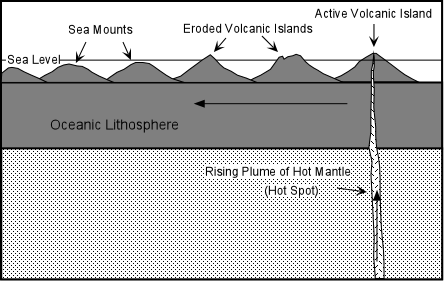 |
| The volcanoes that have moved away from the hot spot eventually begin to erode until their elevations are reduced below sea level. At this point they are called seamounts. |
| Such linear chains of islands and sea mounts are most evident in the Pacific ocean. The largest of these is the Hawaiian - Emperor chain. The hot spot that produced this chain is currently located under the position of the big island of Hawaii, which has the only currently active volcanoes in the chain. The bend in the Hawaiian-Emperor chain must have resulted from a change in the direction of plate motion. Volcanic rocks dredged from the sea floor at the location of this bend are about 40 million years old. Thus, prior to 40 million years ago the Pacific Plate was moving in a more northerly direction. The most northerly seamount is dated at about 60 million years. Seamounts older than 60 million have apparently been subducted. |
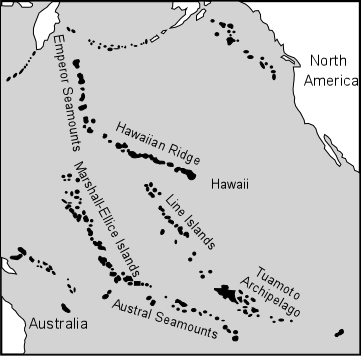 |
| The reason such island/seamount chains are not as evident in the other oceans is because the plate velocity is lower and volcanoes tend to remain over the hot spots for longer periods of time, building elongated groups of islands rather than linear chains. |
| Large Igneous Provinces (LIP)s Large igneous provinces are areas where large volumes of magma have been added to the Earth's crust over relatively short periods of time. Although here we discuss these in terms of the ocean basins, it should be noted that they also include the continental areas where large volumes of magma have been erupted as flood basalts. Eruption of large amounts of magma on the surface of the Earth can have drastic consequences. For example:
The mid Cretaceous Period was a time of higher than normal global temperatures and high
stands of the oceans. Eruption of magma on the ocean floor at this time might have
been the cause of these conditions. Evidence is preserved on the sea floor in the
form of large submarine plateaus that were emplaced during this time period. |
| The map shows a plate tectonic reconstruction at 83 million years before the present. The dark shaded regions show the locations of submarine oceanic plateaus emplaced between 125 and 80 million years ago. Most of these were produced at the oceanic ridges, shown as dark lines, and moved outward from the ridges. These plateaus are numbered and listed in the table below. |
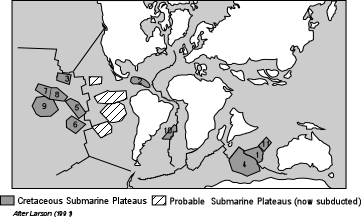 |
Number Name Age (my) Volume (106 km3) 1 Broken Ridge 90 - 110 5.19 2 Caribbean 75 - 90 20.41 3 Hess Rise 95 - 115 7.78* 4 Kerguelen Plateau 90 - 110 24.86 5 Line Islands 75 - 85 10.01 6 Manihiki Plateau 115 - 125 10.4* 7 Macus Wake Seamounts 90 - 115 30.85* 8 Mid Pacific Mountains 75 - 130 42.94* 9 Ontong-Java Plateau 100 - 125 101.35* 10 Rio Grande Rise 85 - 90 7.76 11 Wallaby Plateau 110 - 125 1.49 *Volumes doubled to account for possible twin plateaus that have been subducted.
| In the Pacific Ocean, much of the oceanic lithosphere east of the position of the
ridge 80 million years ago has been subducted. Thus, if the submarine plateaus
formed at the ridge, then it would be expected that half of each plateau became separated
at the ridge and have since been subducted. These probable plateaus are shown in the
map, and if they were present would double the original size of the plateau. Thus,
for example the largest of the plateaus is the Ontong-Java Plateau, now located in the
southeastern Pacific, with a volume of about 50 million km3. But if the
other half had been present, the total volume of magma erupted over a 25 million year
period would have been over 100 million km3. The few studies that have looked at the rocks in these submarine plateaus suggest that their compositions are similar to EMORBs and OIBs. |
Composition |
Oceanic Island Rock Suites Island or Group Rock Types Ascension Oliv. Tholeiite (dominant) + Hawaiite + Mugearite + Trachyte + Peralk. Rhyolite Azores Alk. basalt + Hawaiite + Trachyte Fernando de Noronha Alk. Basalt + Nephelinite + Trachyte + Alkali Basalt + Trachyte + Phonolite St. Helena Alk. Basalt + Mugearite + Hawaiite + Trachyte + Phonolite Trinadade Nephelinite + Phonolite (dominant) Tristan de Cunha Alk. Basalt + Trachybasalt (dominant) + Trachyte Gough Alk. Basalt + Ol Tholeiite + Hawaiite + Trachyte Réunion Ol Tholeiite (dominant) + Mugearite Mauritius Alk. Basalt (dominant) + Mugearite + Phonolitic Trachyte Hawaii Tholeiite (dominant) + Alkali Basalt + Hawaiite + Mugearite + Trachyte Tahiti Alk. Basalt + Mugearite + Hawaiite + Trachyte Galapagos Tholeiite + Alk. Basalt + Icelandite (minor) + Qtz Trachyte (minor) Jan Mayen Alk. Basalt (dominant) + Trachyte
|
|
Shown here is the more common alkaline suite produced at oceanic islands. The most basic rocks are alkaline basalts that show a range of compositions and an Fe-enrichment trend that likely results from fractionation of Mg-rich olivines and pyroxenes. As these magmas become more enriched in iron, hawaiites are produced. The fractionating assemblage then becomes more Fe-rich, likely caused by the addition of magnetite to the crystallizing assemblage. This causes an Fe-depletion trend causing magmas to evolve to mugearites, benmoreites or trachytes, and eventually rhyolites and/or peralkaline rhyolites. |
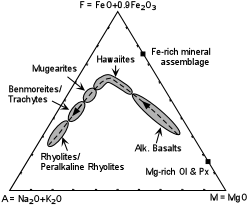 |
|
Perhaps not typical of all oceanic islands, but certainly the most well studied oceanic islands are the Hawaiian Islands. The main portion of each of the islands exposes tholeiitic basalts which appear to make up the most volume. |
|
|
|
At the northwestern end of the island chain is the island of Kauai. Tholeiitic volcanism built Kauai about 5.5 million years ago. As one moves to southeast along the chain the age of tholeiitic volcanism becomes younger, occurring at 3.8 and 2.8 million years ago on Oahu, 2 and 1.7 million years ago on Molokai, and 1.3 and 0.9 million years ago on Maui. The big island, Hawaii, is composed of 5 major volcanoes. The oldest is Kohala whose tholeiitic shield was built about 800,000 years ago. Hualalai and Mauna Kea are somewhat younger, and Mauna Loa and Kilauea are still actively erupting tholeiitic lavas. Although the lower parts of Mauna Kea, on the big island, and Haleakala on Maui are composed of tholeiitic basalts, they are capped by steeper sided composite cones that consist of alkali basalts, hawaiites, mugearites, and trachytes. These alkaline caps are thought to have existed on top of the tholeiitic shields that make up the older islands, but the alkaline rocks have been eroded. The island of Oahu is deeply eroded, but recent volcanism has occurred on the eroded
shield. This post-erosional volcanism, as it is called, consists of highly alkaline
basanites and nephelinites. |
In basic magmas the alkaline elements K and Na behave as incompatible elements, so
crystallization of Mg & Fe- rich phases tends to cause both SiO2 and
alkalies to increase. Thus the general trends are consistent with crystal fractionation as
a mechanism to explain chemical variation in each suite. |
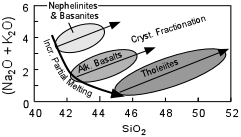 |
|
Finally, after the passage of several million years the volcano has moved farther away
from a position above the hotspot, and thus temperatures are even lower. Melting of
the mantle at this lower temperature would result in lower degrees of melting to produce
the very alkali-rich basanite magmas. |
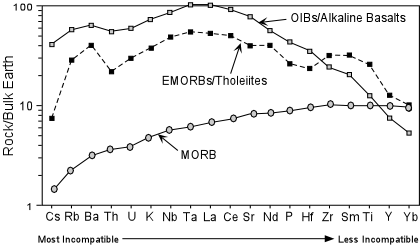 |
Two factors could account for these observations. |
|
 |
Note that on the diagram OIBs lie on a mixing trend between MORBs and continental crust
or oceanic sediment (most oceanic sediment is derived from continental crust). This
suggests that continental crust may somehow be involved in mixing with the depleted MORB
magmas to produce the more enriched OIB magmas. One possibility would be that the magmas
originally start out as depleted MORB-like magmas and assimilate continental crust or
oceanic sediment before reaching the surface. But, direct assimilation of continental
crust can be ruled out because the OIBs are erupting through oceanic crust where no
continental crust is present. Similarly contamination with oceanic sediment is
unlikely because, even though ocean sediment exists in the deep ocean basins, the OIB
magmas are not likely to come in contact with much sediment because they are passing
through large volcanic structures to reach the surface of the island. Another
alternative is that the mantle source of OIBs is mixture of a depleted mantle a mantle
that has been enriched in some way by interaction with continental crustal material. How
this could happen will be considered below in our summary discussion of OIBs. |
Origin
|
|
| One recent theory on how the enriched OIB mantle source could be generated suggests that oceanic sediment (derived from the continents) is carried deep into the mantle by the subduction process. Because subducted lithosphere is cold and dense it may continue to sink into the mantle and eventually reach the core/mantle boundary. In doing so, the subducted material carries some oceanic sediment that is enriched in incompatible trace elements and has high ratios of 87Sr/86Sr and low ratios of 143Nd/144Nd. |
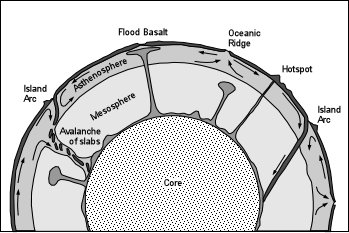 |
| This enriched component mixes with the mantle near the core/mantle boundary to produce an enriched mantle. The enriched mantle eventually heats up as a result of heat released from the Earth's core. When it is sufficiently hot it begins to rise in narrow plumes that channel the enriched mantle upward and produce hotspots as they rise through the asthenosphere, eventually melting to produce the variety of OIBs and EMORBs erupted from oceanic islands.. |
Examples of questions on this material that could be asked on an exam
|